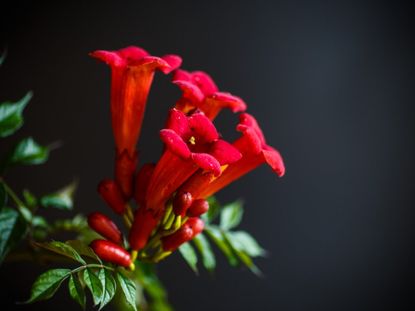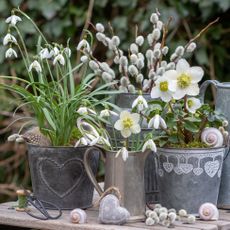Trumpet Plant Propagation – How To Root Trumpet Vine Cuttings


Also appropriately known as hummingbird vine, trumpet vine (Campsis radicans) is a vigorous plant that produces lush vines and masses of showy, trumpet-shaped blooms from midsummer to the first frost in autumn. If you have access to a healthy plant, you can easily start a new trumpet vine from cuttings. Read on to learn the basics of this trumpet plant propagation.
How to Root Trumpet Vine Cuttings
Propagating trumpet vine cuttings can be done any time of year, as the vines root readily. However, starting trumpet vine cuttings tends to be most effective in spring when stems are tender and flexible. Prepare a planting container ahead of time. A small pot is fine for one or two cuttings, or use a larger container or a planting tray if you plan to start several cuttings. Be sure the container has at least one drainage hole. Fill the container with clean, coarse sand. Water well, then set the pot aside to drain until the sand is evenly moist but not dripping wet. Cut a 4 to 6-inch (10 to 15 cm.) stem with several sets of leaves. Make the cutting at an angle, using a sterile knife or razor blade. Remove the lower leaves, with one or two sets of leaves remaining intact at the top of the cutting. Dip the bottom of the stem in rooting hormone, then plant the stem in the moist potting mix. Place the container in bright but indirect light and normal room temperatures. Water as needed to keep the potting mix consistently moist, but never soggy. After about a month, tug gently on the cutting to check for roots. If the cutting has rooted, you’ll feel a slight resistance to your tug. If the cutting offers no resistance, wait another month or so, and then try again. When the cutting has successfully rooted, you can transplant it to its permanent spot in the garden. If the weather is chilly or you aren’t ready to plant your trumpet vine, transplant the vine to a 6-inch (15 cm.) pot filled with regular commercial potting soil and allow it to mature until you’re ready to plant it outdoors.
Gardening tips, videos, info and more delivered right to your inbox!
Sign up for the Gardening Know How newsletter today and receive a free download of our DIY eBook "Bring Your Garden Indoors: 13 DIY Projects For Fall And Winter".

A Credentialed Garden Writer, Mary H. Dyer was with Gardening Know How in the very beginning, publishing articles as early as 2007.
-
 Grow A Container Winter Wonderland: 7 Best Winter Flowers For Pots With Cool-Season Cheer
Grow A Container Winter Wonderland: 7 Best Winter Flowers For Pots With Cool-Season CheerContainers don’t need to go into hibernation in colder months – there’s still plenty of floral life to be enjoyed! We round up some of the very best winter flowers for pots
By Tonya Barnett
-
 How To Buy The Best Electric Composter: Read This Before Spending $100s On A Countertop Food Recycler
How To Buy The Best Electric Composter: Read This Before Spending $100s On A Countertop Food RecyclerElectric composters and countertop food recyclers offer a super-fast solution to tackling food waste – and can help create nutrient-rich compost. Choose the best model for your needs with our expert guide.
By Melanie Griffiths